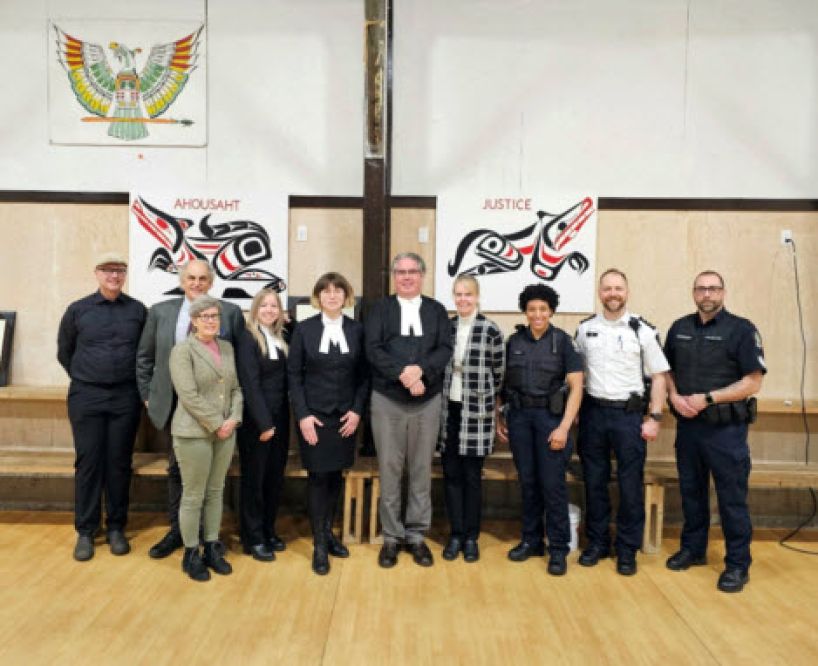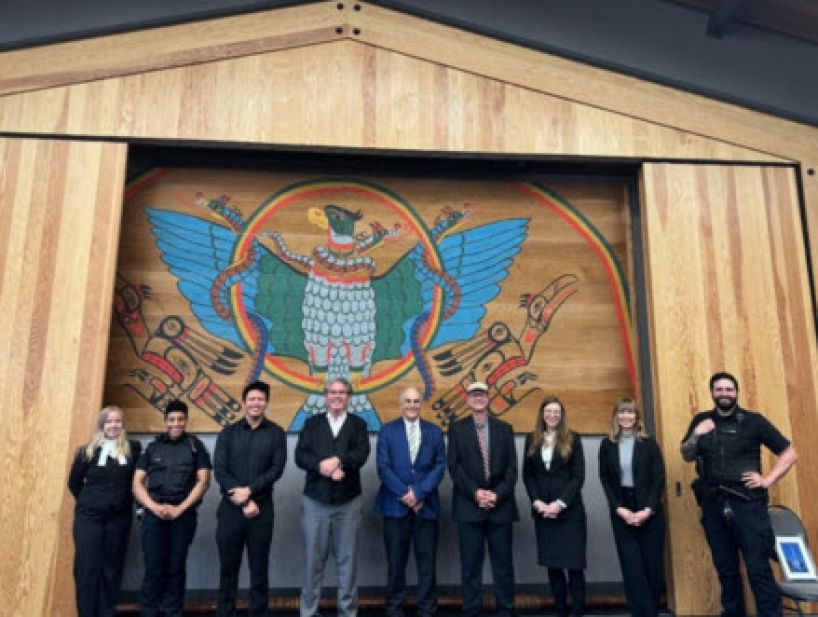Working together with Indigenous communities

September 30, 2024 is the National Day for Truth and Reconciliation, a day when we honour survivors of residential schools, the children who never returned home, and their families and communities. But reconciliation with Indigenous peoples is a year-round commitment for the Provincial Court.
Working with First Nations to increase their access to justice is an important part of our reconciliation efforts. This year, the Court accepted the invitation of the Ahousaht and Tla-o-qui-aht First Nations to sit in their communities.
The Ahousaht and Tla-o-qui-aht communities are two of fourteen Nuu-chah-nulth First Nations located on or near Vancouver Island. They have a shared language of Nuu-chah-nulth. They have shared with the Court that one of their core values is Iisaakstalth: respect one another. Another core value is the idea of Heshook-ish Tsawalk, that everything is interconnected.
Ahousaht First Nation
A judge, court clerk, sheriff, probation officer and lawyers travelled by boat to hold court in Maaqutusiis on Vancouver Island’s west coast on April 9, June 4, and August 13, 2024. Dates have also been set for court sittings there in 2025.

The Ahousaht First Nation is the largest member of the Nuu-chah-nulth Tribal Council, with 2,100 members living on Vancouver Island and elsewhere. Many community members live in Maaqutusiis, which is on Flores Island about a 40 minute boat ride from the nearest court location in Tofino.
In the past, community members had to spend $60.00 for a return boat trip to attend court in Tofino and their supporters might not be able to go with them. If they didn’t attend and an arrest warrant was issued, making the arrest would cost the small Ahousaht RCMP detachment time and resources. It would sometimes involve transportation to correctional facilities. When the Court sat in Ahousaht on August 13, the victim services worker pointed out that for the first time in recent memory, no arrest warrants were issued. Everyone had attended court.
On each of the Ahousaht circuit court sittings, a community member welcomed the opening of the court with a traditional Nuu-chah-nulth song. For the first court sitting in April, Chief Judge Melissa Gillespie and Regional Administrative Judge Carmen Rogers joined the court participants and members of the community for homemade soup and salmon sandwiches during the lunch break. When the meal was finished, they exchanged welcoming comments and ceremonial gifts.
The Court serves several remote communities by sending a judge and court staff to hold court in a community hall, recreation centre, or other facility. The judge, court staff, sheriff, probation officer and lawyers may travel by boat, float plane, or four-wheel drive vehicles to reach the community.
These “circuit courts” allow the judge and community to communicate and work together to restore the sense of harmony that has been harmed by offending behaviour. Bringing the court to the community, enables Elders, local counsellors, and other community members including the victim to participate directly in the court process.
Tla-o-qui-aht First Nation
On September 9, 2024 the BC Provincial Court had its first sitting on the Tla-o-qui-aht territory, known as Ha-Hoothlee territory. This First Nation is located near Tofino on the West Coast of Vancouver island and has over 1200 members.
During the last few years, the Tla-o-qui-aht Nation created a nine-member Justice Committee that has been active in helping victims and offenders involved in court proceedings. Their goals include increasing the voice of victims in court proceedings and supporting offenders’ rehabilitation to permit their eventual reintegration into their home communities.
The September sitting was held in a room on the ancestral site where the Christie Residential School operated from 1971 to 1981. The Tla-o-qui-aht Nation created a conference centre from the residential school’s gymnasium and uses it to support positive community and cultural activities.

There was a strong community presence at the first sitting. All Justice Committee members and other community members participated, offering information about victims and supports available through the First Nation.
On the lunch break the court party, justice committee, Elders, Tla-o-qui-aht elected council members and hereditary chiefs, Ha’wiih, enjoyed homemade stew and bread provided by the Tla-o-qui-aht Justice Committee. There was an exchange of comments and gifts to celebrate the circuit court’s inaugural sitting.
The British Columbia Provincial Court is honoured to work with Indigenous communities in the development of creative approaches that increase access to justice. Nine Indigenous sentencing courts, an Aboriginal Family Hearing Case Conference court, and court circuits in many BC communities are examples of what can be done when our courts and communities work together.
More information
Circuit courts
Indigenous sentencing courts
Court locations and sitting dates
This page was printed from:
https://provincialcourt.bc.ca/news-notices-policies-and-practice-directions/enews/working-together-indigenous-communities
